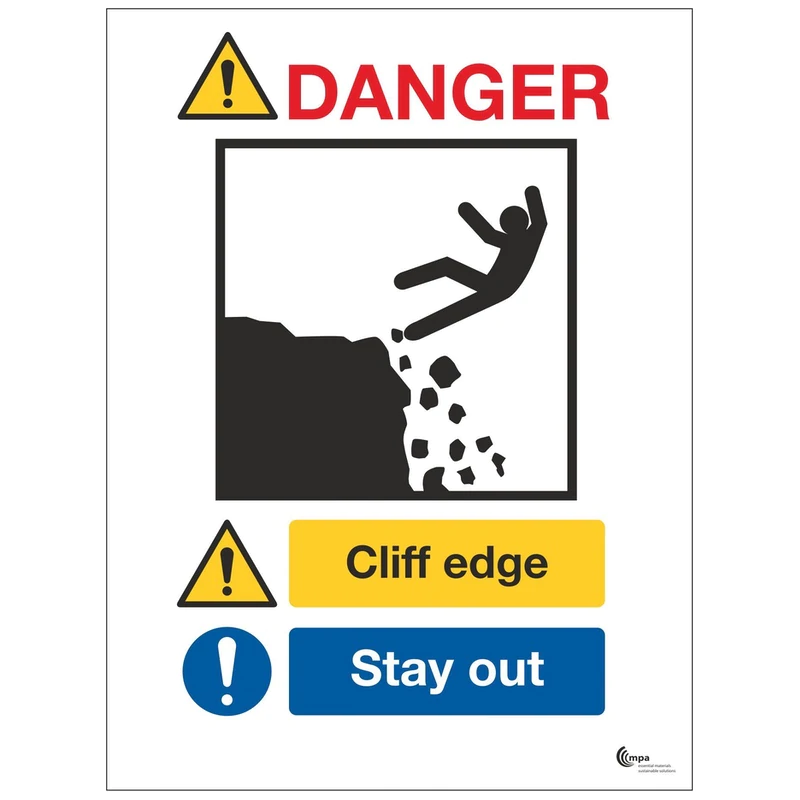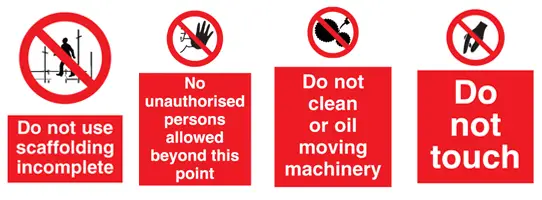How Safety Signs Improve Workplace Safety: Best Practices for Implementation
Guide to Selecting the Right Safety Indications for Any Kind Of Environment
Choosing the suitable safety and security indicators for different settings is a crucial element of danger administration and governing conformity. It calls for a detailed understanding of the particular dangers existing, as well as an awareness of the lawful structures governing indicator usage.
Comprehending Safety Indicator Kind
Safety and security signs play a vital role in preserving a risk-free setting, and comprehending the various types is important for efficient communication of hazards. These signs are classified mainly into 4 types: indication, mandatory signs, prohibition indications, and educational signs.
Warning indicators are triangular and normally yellow, alerting people to possible hazards that may cause injury or damage. Compulsory indications, often circular and blue, indicate activities that need to be taken to ensure safety, such as putting on individual protective tools. Restriction indications, defined by a red circle with a diagonal line, plainly suggest actions that are not allowed, such as cigarette smoking or going into a limited location. Educational indications provide guidance or instructions, typically using environment-friendly for risk-free conditions, blue for compulsory actions, and yellow for caution-related messages.
Understanding these groups aids in choosing the appropriate indications for specific atmospheres. By making use of the appropriate security signs, organizations can efficiently communicate risks, promote conformity with safety protocols, and eventually cultivate a society of safety that safeguards staff members and site visitors alike.
Evaluating Your Atmosphere
Examining the details qualities of your atmosphere is essential to choosing the proper safety and security indicators. Various setups, such as commercial facilities, construction sites, or office atmospheres, each present one-of-a-kind risks and functional contexts that have to be taken into consideration.
Begin by identifying potential risks within your environment. For example, in a factory, hefty machinery and high noise levels may demand signs indicating personal protective equipment (PPE) demands, while a medical care setup may require indications informing personnel to biohazard locations.
Next, assess the physical layout of the area. Take into consideration the exposure of signs; they ought to be put where they can be easily seen and understood by individuals moving with the location. Examine lighting problems, as poorly lit areas may call for reflective or illuminated signs to improve visibility.
In addition, consider the target market interacting with the indications. Varied labor forces might necessitate multilingual signs or icons that convey messages plainly without dependence on text. Evaluating these elements will ensure that the security indicators selected successfully interact necessary preventative measures, inevitably promoting a more secure atmosphere for all.
Regulatory Conformity Factors To Consider
Recognizing regulatory compliance is crucial when selecting security indicators, as it guarantees that your signs fulfills both lawful requirements and industry standards - Safety Signage. Conformity with regulations not only secures your organization from possible fines but likewise improves office security and promotes a culture of duty
First, familiarize yourself with the appropriate laws and guidelines that put on your certain market. This might include federal, state, and neighborhood requireds, along with specific standards from companies such as OSHA (Occupational Security and Health Management) or ANSI (American National Requirements Institute) These guidelines determine the kinds of signs required, their placement, and the language used.
Following, take into consideration the details threats existing in your setting. Particular markets, such as construction or production, may have special signage demands that mirror the risks included. Furthermore, make certain that your indicators are compliant with access requirements, making them easily legible for all workers.
Designing Effective Safety And Security Signs
Reliable security indications are not only a governing demand yet also a vital component of a thorough security approach. To create effective safety and security indicators, it is important to focus on quality and visibility. Making use of widely recognized signs and straightforward language can considerably improve comprehension. Indications must be made with high-contrast colors to guarantee they are quickly legible from a distance, even in low-light conditions.
In addition, the positioning of safety signs is crucial. Health and Safety Signs. Safety Signage Indications have to be placed at eye level and in places where they can be conveniently seen by people in the vicinity. It is likewise important to think about the specific target market; as an example, signs in commercial environments might need more technological language, while those in public areas ought to remain accessible and basic
Including ideal dimensions and materials is an additional crucial element. Indicators need to be weather-resistant and long lasting if put outdoors, while indoor signage may need various factors to consider based on the setting. Eventually, the goal of developing security indicators is to communicate necessary information efficiently, ensuring that people can rapidly recognize possible threats and respond suitably, therefore promoting a safer environment for everybody.

Maintenance and Updates
Consistently carrying out upkeep and updates for security indicators is necessary to guarantee their continued effectiveness and presence. Over time, environmental variables such as wind, rain, and sunlight can weaken the products utilized in safety indications, bring about fading, peeling, or total disintegration. Routine inspections need to be set up to evaluate the problem of all security signs within any type of given environment.
Upgrading safety and security indicators is similarly crucial, specifically when there are modifications in procedures, regulations, or threats. Organizations has to stay abreast of neighborhood legislations and sector standards to guarantee conformity. Safety Signs. When modifications are made to the work space, such as new equipment setups or changes in layout, corresponding updates to security signs must be implemented right away
It is additionally a good idea to preserve a constant supply of safety and security signs, ensuring that substitutes are conveniently available. This proactive technique lessens downtime and improves safety by reducing threats associated with broken or out-of-date signs. Finally, an effective upkeep and upgrade technique for security signs not just protects their functional stability but likewise strengthens a culture of safety within the workplace.
Final Thought
In summary, the choice of suitable safety and security indicators is critical for making sure a safe atmosphere. A comprehensive understanding of the kinds of indications, detailed assessment of potential dangers, adherence to regulatory requirements, efficient layout principles, and regular upkeep add to improved communication and safety. By applying these strategies, companies can cultivate a society of security that advertises and protects individuals compliance with security laws, ultimately causing a much safer and more safe office.
Evaluating these variables will certainly ensure that the safety indications chosen successfully interact required preventative measures, inevitably promoting a much safer atmosphere for all.
Effective safety signs are not just a governing need however likewise a crucial component of an extensive security approach. Ultimately, the goal of designing safety and security signs is to communicate crucial info efficiently, making certain that people can quickly recognize potential risks and respond properly, therefore cultivating a safer atmosphere for everyone.
In conclusion, an effective upkeep and update approach for safety indications not only protects their functional honesty but also strengthens a society of security within the office.
